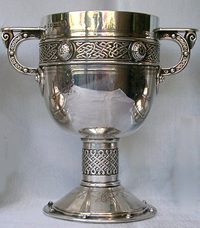J. O. Westwood's publication of examples from the Book of Kells in 1843 marks the rediscovery of Celtic interlace decoration,
and over the next 25 years it was featured in isolated instances by a handful of antiquaries, authors, and architects.
The Victorian public's interest in Celtic items commenced with the discovery of the Tara Brooch in 1850.
This was reproduced by the Dublin jewellers, Waterhouse & Co, and displayed at the Great Exhibition of 1851,
where two Waterhouse copies of the Tara Brooch were patronised by Queen Victoria for herself and Prince Albert.
This started a Victorian craze for Celtic jewellery. However in the main these were exact reproductions,
rather than original designs, and aside from a few one-off curiosities,
such as the 1860 racing trophy for the Doncaster Cup, no Celtic style domestic objects
other than jewellery appeared, until the production of Elkington's Celtic Chalice and Jug.

The first Celtic Revival domestic silverware is usually credited to Edmond Johnson of Dublin, who produced items based on the Ardagh Chalice around 1896, or to the earliest creations by Archibald Knox for Liberty & Co, circa 1898.
Christopher Dresser is occasionally refered to as a minor source in the Celtic Revival, referencing his Celtic wallpapers and book illustrations from the 1860's and 1870's. However it now seems likely that his Celtic graphic designs are part of a greater body of work.
If this Chalice from 1876 and the later Jug prove to be Dresser's, they show his mastery designing distinctive silverware in a Celtic Revival style, 20 years before other designers.
Christopher Dresser is a towering figure in the evolution of modern design, with numerous accolades. Perhaps to these should now be added, First Designer of The Celtic Revival.
As a punch bowl it is twice the scale of the Ardagh Chalice. It is a quasi-replica using the same design elements as the earlier 1876 Elkington Chalice. It is certainly not an exact historical replica (or electrotype) of the actual Ardagh Chalice.
Hopefully sometime soon a researcher with access to the Elkington archives can check whether these records contain documentary evidence proving Christopher Dresser was the designer of these Elkington Celtic silver items.
Further information on Christopher Dresser and The Celtic Revival is welcomed via eMail: